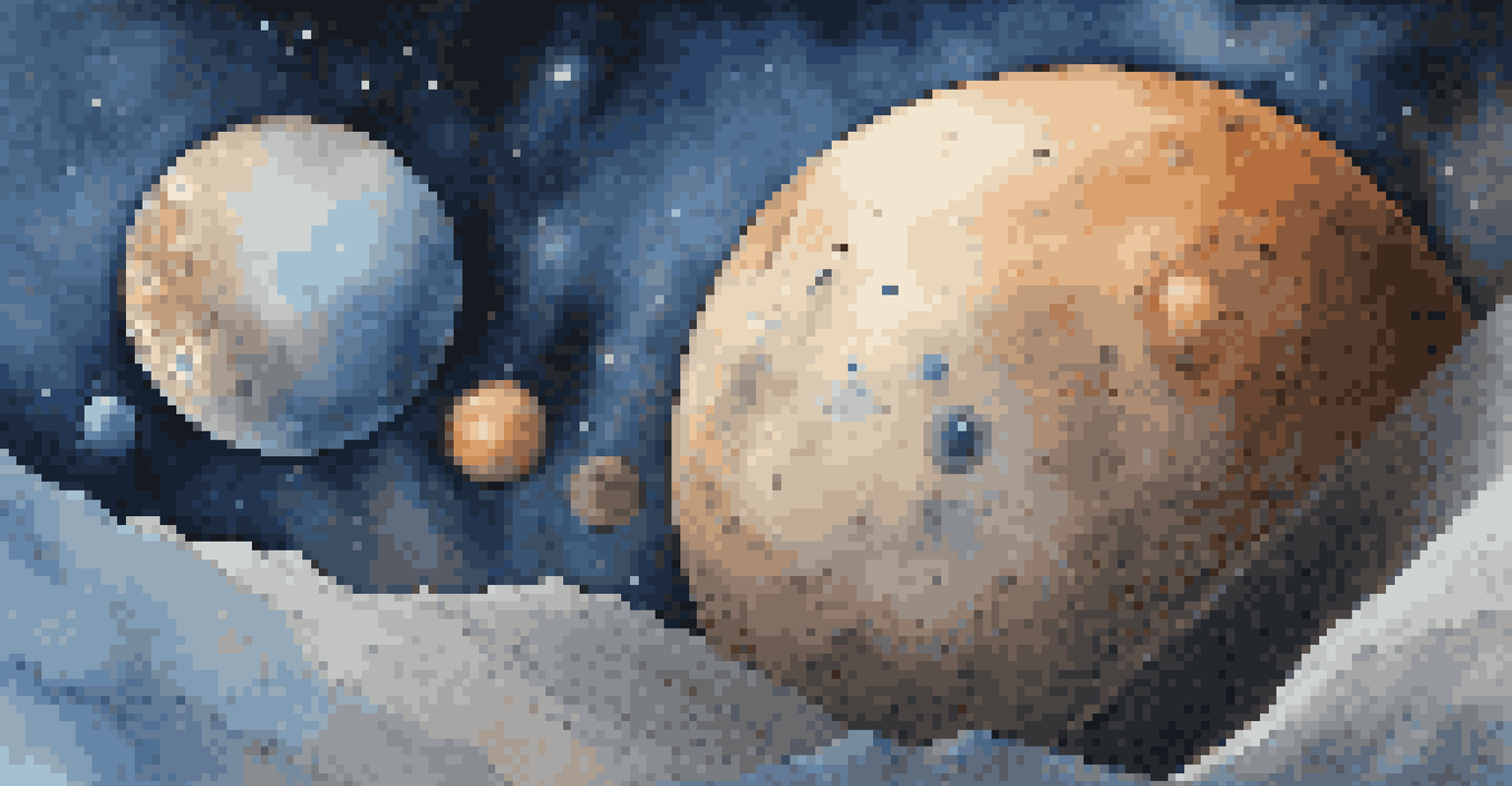The Kuiper Belt: Home to Dwarf Planets and More

What is the Kuiper Belt and Where is It Located?
The Kuiper Belt is a vast region of space beyond Neptune, filled with icy bodies and remnants from the solar system's formation. Spanning from about 30 to 55 astronomical units (AU) from the Sun, this area is often likened to a cosmic treasure trove. Imagine a ring made of snowballs, where each snowball represents a different celestial object. This unique region is crucial for understanding the early solar system and the formation of planets.
The universe is under no obligation to make sense to you.
Discovered in the 1990s, the Kuiper Belt is home to many fascinating objects, including dwarf planets like Pluto, Haumea, and Makemake. These dwarf planets are not just smaller versions of regular planets; they each possess unique characteristics that make them intriguing to scientists and space enthusiasts alike. For instance, Haumea has a distinctive elongated shape, believed to be caused by its fast rotation, while Makemake is known for its bright surface and limited atmosphere.
The Kuiper Belt also serves as a boundary between the inner solar system, where the terrestrial planets reside, and the outer solar system's gas giants. This distinction helps astronomers categorize celestial objects and understand their origins. So, the next time you gaze at the night sky, remember that beyond what we can see lies a bustling area filled with icy wonders waiting to be explored.
Dwarf Planets: The Stars of the Kuiper Belt
Dwarf planets are the standout features of the Kuiper Belt, and they have unique attributes that set them apart from traditional planets. To qualify as a dwarf planet, an object must orbit the Sun, have enough mass for a nearly round shape, and not clear its orbital path of other debris. Pluto, perhaps the most famous of all dwarf planets, was reclassified from a full planet in 2006, sparking debates and discussions that continue today.

In addition to Pluto, Haumea and Makemake are also recognized as dwarf planets, each with their own distinct characteristics. Haumea is especially notable for its rapid rotation and elongated shape, which makes it unique among its peers. Meanwhile, Makemake is often described as a dark, cold world, demonstrating the diversity within the Kuiper Belt's icy residents.
Kuiper Belt: A Cosmic Treasure Trove
The Kuiper Belt is a vast region beyond Neptune, filled with icy bodies and remnants from the solar system's formation.
Studying these dwarf planets provides insights into the conditions of the early solar system. They act as time capsules, preserving information about the solar system's history and the processes that shaped it. By examining their surfaces and atmospheres, scientists hope to unlock more secrets about the formation and evolution of our cosmic neighborhood.
The Significance of the Kuiper Belt in Astronomy
The Kuiper Belt is not just a collection of icy bodies; it plays a significant role in our understanding of astronomy and planetary formation. This region is thought to be a remnant of the protoplanetary disk that surrounded the young Sun, making it a critical area for studying how planets formed and evolved over time. Imagine piecing together a historical puzzle, where each Kuiper Belt object is a crucial piece that helps complete the picture.
Somewhere, something incredible is waiting to be known.
Moreover, the Kuiper Belt serves as a source of comets that occasionally venture into the inner solar system. These comets, originating from the Kuiper Belt, can provide valuable information about the early solar system's conditions. When they approach the Sun, they develop tails that can be observed from Earth, allowing astronomers to study their composition and behavior.
Additionally, the Kuiper Belt challenges our understanding of celestial dynamics. As researchers study the gravitational interactions between Kuiper Belt objects and the giant planets, they gain insights into how these forces shape the orbits of various celestial bodies. This ongoing research helps refine our models of the solar system and the forces at play.
Exploring the Kuiper Belt: Missions and Discoveries
Exploration of the Kuiper Belt has gained momentum in recent years, leading to significant discoveries and exciting missions. NASA's New Horizons spacecraft made headlines in 2015 when it flew by Pluto, providing breathtaking images and data that transformed our understanding of this distant dwarf planet. This mission marked the first close-up exploration of any Kuiper Belt object, and its success paved the way for future missions.
After its encounter with Pluto, New Horizons continued its journey deeper into the Kuiper Belt. In 2019, it flew by a small object named Arrokoth, also known as 2014 MU69, which is thought to be a building block of the early solar system. The data collected during this flyby revealed valuable insights into the formation of planets and the conditions that existed billions of years ago.
Dwarf Planets: Unique Celestial Bodies
Dwarf planets like Pluto, Haumea, and Makemake each have distinct characteristics that provide insights into the solar system's history.
Looking ahead, several missions are planned to further explore the Kuiper Belt and its intriguing objects. These missions aim to gather more data on the composition, structure, and evolution of Kuiper Belt objects, ultimately enhancing our understanding of the solar system's history. As technology advances, the excitement surrounding these explorations continues to grow.
The Kuiper Belt's Role in Understanding Planetary Formation
The Kuiper Belt provides essential clues about planetary formation and the early solar system. Scientists believe that the objects within the belt are remnants from the solar system's formation, preserving a snapshot of its early conditions. By studying these ancient bodies, astronomers can piece together the processes that led to the creation of planets.
One key aspect of planetary formation is the concept of accretion, where dust and ice particles collide and stick together to form larger bodies. The Kuiper Belt is thought to contain many of these building blocks that never coalesced into full-fledged planets, offering a unique perspective on the dynamics of planetary formation. It's like examining the leftovers from a cosmic kitchen, providing insights into what went into the final dish.
Additionally, studying the various compositions of Kuiper Belt objects helps researchers understand the diversity of materials present in the early solar system. This knowledge can shed light on how different planetary systems might form in other parts of the galaxy, ultimately enhancing our understanding of our place in the universe.
Potential for Future Discoveries in the Kuiper Belt
The Kuiper Belt is a treasure trove of scientific potential, with many mysteries yet to be unraveled. As technology advances, astronomers are continually discovering new objects within this region, expanding our knowledge and understanding of its complexities. Each new discovery opens up the possibility of gaining fresh insights into the solar system’s history and evolution.
One exciting prospect is the potential for finding additional dwarf planets or even new types of celestial bodies that challenge our current classifications. The recent discovery of several small, icy objects hints at the possibility of a more diverse and complex Kuiper Belt than previously thought. Each of these objects can provide valuable data that enriches our understanding of the solar system.
Future Discoveries Await in the Belt
As technology advances, the Kuiper Belt holds the potential for new discoveries that could reshape our understanding of planetary formation.
Moreover, the ongoing exploration of the Kuiper Belt may lead to discoveries that reshape our understanding of planetary systems beyond our own. By studying the diversity of objects and their orbits, we can gain insights into the processes that govern planetary formation across the cosmos. The Kuiper Belt, with its icy residents and hidden secrets, continues to be a focal point for astronomers and space enthusiasts alike.
The Kuiper Belt and Its Mysteries: A Final Word
The Kuiper Belt remains one of the most intriguing regions in our solar system, filled with mysteries waiting to be uncovered. From the celestial wonders of dwarf planets to the icy bodies that serve as time capsules of our solar system's past, this region offers a wealth of information for researchers. Each new discovery adds another layer to our understanding of the universe and our place within it.
As we continue to explore the Kuiper Belt, we not only learn about our own solar system but also gain insights into the formation of planetary systems throughout the galaxy. The study of this distant region encourages collaboration among scientists and inspires the next generation of astronomers to push the boundaries of what we know.

In conclusion, the Kuiper Belt is much more than just a distant collection of icy objects; it is a vital part of the story of our solar system. With ongoing research and exploration, who knows what new revelations await us in this cosmic frontier? The journey of discovery continues, and the mysteries of the Kuiper Belt are sure to captivate our imaginations for years to come.